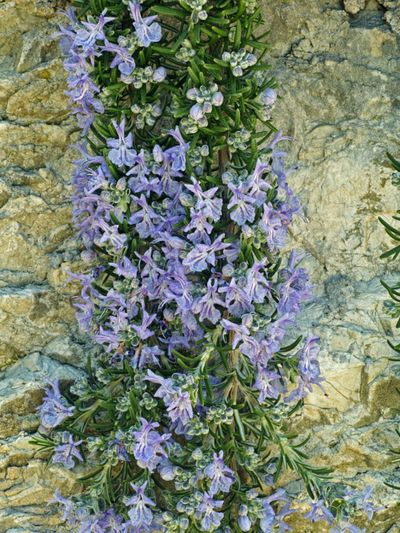Creeping Rosemary Information
Prostrate rosemary in the landscape is an easy to care for creeping perennial herb suitable for the herb garden, perennial beds, containers, and rockeries. A low growing herbaceous shrub, prostrate rosemary plants can be grown throughout USDA Plant Hardiness Zones 8 to 10. The plant only grows to a height of about 2 inches to 1 foot tall (5-30 cm.) and will spread 4 to 8 feet (1-2 m.) if left unchecked. The best time to plant prostrate rosemary is in the fall. Plant your creeping rosemary (Rosmarinus officinalis ‘Prostratus’) in full sun to part shade in well draining soil, although it will do well in almost any type of soil so long as it is not allowed to become sodden. You will be rewarded with an aromatic evergreen with gray green leaves reminiscent of pine needles and attractive light purple flowers.
Growing Prostrate Rosemary Plants
Prostrate rosemary plants can be purchased at the local nursery and may also be found under the names Blue Agave, American Aloe or Maguey. Conversely, you can propagate rosemary by clipping 2 inches (5 cm.) of soft, new growth. Remove the lower inch of leaves, dip in rooting hormone and then place the start in damp, sterile seed mix. Place the new plant in indirect sunlight in a warm area and mist daily. Roots should begin to form after about two to three weeks, at which time you can transplant into pots to continue to grow. After three months, the rosemary is big enough to transplant outdoors in a full sun exposure, four to six hours per day. Trim any extra long or damaged branches on the rosemary. Dig a hole a couple inches deeper than the root ball of the herb. Mix 2 to 4 inches (2.5-10 cm.) of shredded bark or gravel into the soil to provide better drainage. Plant the rosemary and back fill the hole. Water the plant in, taking care not to drown it. Additional plant should be space 24 to 36 inches (60-90 cm.) apart in the garden.
Care of Trailing Rosemary
The care of trailing rosemary is quite simple. Water, but don’t drown the plant. Remember, rosemary is used to dry conditions. Fertilize rosemary with 1 ½ tablespoons (22 mL.) of slow release 10-10-10 fertilizer around the base of the plant and work in lightly with a hand cultivator. Follow up with some water to activate the fertilizer. Not only is prostrate rosemary a no-fuss herb, it is also drought tolerant and primarily pest resistant. That said, keep weeds away from around the base of the rosemary. Spittle bugs, the one pest rosemary doesn’t seem to be resistant to, may use the weeds as living quarters while they snack on your rosemary. A spray from the hose may be enough to wash them off. A half inch (1 cm.) layer of white sand around the rosemary’s base will also reduce weed growth and decrease the possibility of root rot. Your new rosemary herb can be used either fresh or dry with foods such as roasted potatoes, lamb, pork, fish and poultry dishes and veggies. You can also throw some on the grill when barbecuing to impart a lovely flavor or even use mature woody stems as skewers over the grill.
